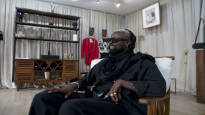KIGALI, RWANDA Last summer, a Rwandan Moses Turahirwa31, watched the clothes she designed fly by on a catwalk set up in the courtyard of a neoclassical villa in Florence, Italy.
That was the first time that the clothing brand Moshions clothes seen in what is considered the most significant in the world (you move to another service) at the men’s fashion event Pitti Uomo.
– I am proud that through my clothes Rwandan aesthetics can be seen in the world. It is a personal achievement for me, because I come from a remote place where there were no connections with fashion, says Turahirwa.
That remote place was the small town of Nyamasheke in western Rwanda. When I was small, the family mostly used old clothes from Westerners, donated from the church.
At the age of 12, Turahirwa designed for the first time rib clothes for herself and her sister, and a local seamstress made them.
A good decade passed after that, and the young designer founded his own brand.
While others sewed from the colorful igitenge fabrics typical of the African continent, Turahirwa stuck to simple colors and designs. The patterns on her clothes breathe Rwandan cultural heritage.
– The patterns are historical Rwandans, but I have modernized them. It is an honor for me to be involved in defining what Rwandan dressing is, says Turahirwa.
Not for clothes worn by Westerners
Turahirwa’s clothing brand Moshions is one of the many Rwandan clothing brands born in the last decade.
It has grown steadily since 2015 and now employs more than 40 people in Rwanda and Italy. On the home continent, the brand is in high demand, and it has been worn by, for example, the president of Rwanda Paul Kagame and his family and a famous Nigerian author Chimamanda Ngozi Adichie.
Located in East Africa, Rwanda, with a population of approximately 13 million, has invested in the development of its own textile sector in recent years.
As part of the strategy, the country has banned the import of used clothes from Western countries in 2016. Used clothes in East African countries have been a business worth hundreds of millions since the First World War, and their sales have provided jobs for an estimated 350,000 people (you switch to another service).
At the same time, however, it has meant that Africans have dressed themselves in the old clothes of Westerners.
The administrations of the countries in the region justified the import ban by saying that the trade in used clothes prevents the local textile sector from developing.
However, a large number of countries in the region backed away from the ban when threatened by the US administration Donald Trump’s during the presidency to increase customs duties on goods imported from the countries. Rwanda was the only one that stayed with your decision (you switch to another service).
Support from the state for entrepreneurs in the clothing industry
The decision has taken away jobs from working with used clothes and also created a new way of making a living, where used clothes are brought from neighboring countries to be sold in Rwanda illegally.
On the other hand, it has created work in textile production, he says Joselyne Umutoniwase. He is the founder of a clothing brand called Rwanda Clothing.
The company makes furniture, household goods and clothes, and has also grown in 11 years to employ 45 people.
In recent years, more have also been opened in Rwanda factory of an international clothing brand (you switch to another service).
Rwanda supports local clothing entrepreneurs by, for example, making it easier to get loans, supporting their trips to international fashion events, and offering tax-free import of materials to the country.
For example, Moses Turahirwa received a loan for postgraduate studies and completed a master’s degree in fashion design in Florence, Italy in 2021.
The designer says that he has seen how the clothing sector has become an attractive option for Rwanda’s relatively large young population in recent years. You no longer have to go to Paris to get into the industry, he says.
– When I started, there were a few designers in the industry. Since then, there have been many more brands, he says.
Many still buy fast fashion
Rwanda’s intention to grow its own clothing sector has paid off. Although the trade dispute decreased exports to the United States, according to the administration, clothing exports to foreign countries have increased by several tens of percent per year since 2016.
Despite the development, many Rwandans cannot afford to buy locally made fashion. Rwanda’s GDP per capita was in 2021 approximately 764 euros (you switch to another service). For example, the prices of Moshions collared shirts start at 175 euros.
According to Turahirwa, the brand is mainly bought by Rwandans living abroad and tourists visiting the country, of which there are more and more due to the growth of the tourism industry.
More and more can be seen on many Rwandans Cheap fashion imported from China (you will switch to another service). Cheap fashion imported from China to African countries is often even worse in quality than exported to Europe. According to Turahirwa, Rwanda should talk more about the sustainable consumption of clothes.
– We should curb imports from China and tell people that you don’t have to wear new clothes every weekend, he says.
For the article, an interviewer has been interviewed at the University of Edinburgh, who is doing a dissertation on gendered livelihoods on the border between Rwanda and the Congo. Summer Lensua.
Listen to Maria Tolsa’s and Jenna Vehviläinen’s Rwanda-related Measa maila pahuuu podcast:
